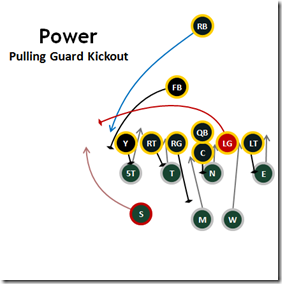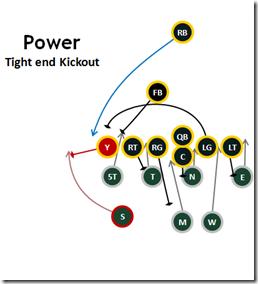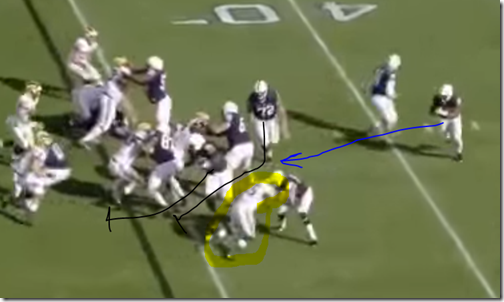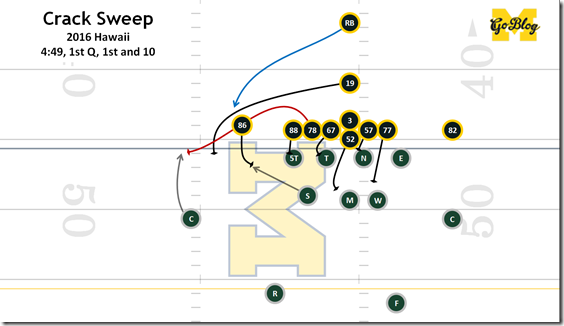What Is: A Kickout Block/Force Player

You have read somewhere that power offenses like Michigan are often dependent on winning big, strong, man-a-mano battles. While that's quite an oversimplification, it's also a truth. Run defenders are usually given pretty simple assignments like "defend this gap at all costs!" or "don't let anyone outside you and hit anyone who tries" so confusing them into leaving your lane open is not sustainable. Sometimes you just need to shove the dude out of the way to make a gap. Sometimes you gotta…
[MC5 lyric you know is coming is not safe for work]
There's plenty going on in that play, but we're going to focus on two opposing concepts that are in play on just about every running play:
FORCE PLAYER
Fritz Shurmer:
"The defender who is responsible for tackling or making sure the ballcarrier does not get outside of him. It is his responsibility either to tackle the ballcarrier or to force him to cut back into the pursuit pattern."
I took that quote from a coachoover post post worth reading. The force defender is being pulled in two directions. He MUST set up far enough outside that he won't get edged, but he's also got to be far enough inside to keep the gap small. Typically you put a little money in the bank; if the ballcarrier tries to go outside of you he's going to either run right into you or the sideline. The sideline is helpful but also passive. Better to redirect the ballcarrier to your friends.
That said, the force defender can't be too conservative. Goal A is set the edge, but every step towards the edge is a lane that's one step wider. The force defender sets up at a 45 degree angle, able to attack upfield or across it. That setup also gives him leverage to not get blown back by a…
KICKOUT BLOCK
Football Outsiders:
Kickout block – On a running play, this blocker is running parallel to the line of scrimmage and his job is to to keep the outside edge rusher (usually a DE or OLB*) from crashing to the inside. It's almost always a fullback or a pulling guard who does the kickout block. Opposite of a crackback block.
* [or, like in the video above, a Cover 2 cornerback.]
If a force player has done his job well, there isn't much space between the force player's area of effect and the defensive pursuit. A kickout block attacks the force defender, thwacking him toward the sideline, preventing him from a tackle attempt, and creating a running lane over the resulting viscera. That's why FO says it's almost always an offensive lineman or fullback.
A kickout block is going to go as well as physics allow: the more accelerated mass you can hit him with, the more room there is to run.
[Hit THE JUMP to see it in action]
HOW DO YOU DO THAT?
A kickout block isn't as footwork dependent as other blocks—the contact and leverage at the contact point are the big things. A kickout blocker wants to be the low man, bent at the waist with his body weight over his butt, when the impact occurs, so he can then spring up and into the defender, popping that guy out of the hole. Then the blocker maintains contact and tries to continue shoving that dude toward the sideline, or if the defender won't budge, deep into the bowels of the Earth.
A close cousin of the kickout is the "Log" block, where you run the defender upfield to widen the gap and cut off pursuit. The way this goes is rarely in the playcall—you get the best block you can, with the goal always to keep that guy sealed outside and expand the running lane. Like, Magnuson in our image just put a leaping 300-pound man in between the force defender's knees and the ballcarrier, turning his kickout into a cut block. This is about function not form.
IS THAT IT?
Let's look at a typical "Power" play. That's the base Manball running play where the backside guard pulls, everyone else blocks down, and the back hits the resulting hole behind a lead blocker.
Your standard 4-3 defense is going to fill those lineman gaps with their DL and middle linebackers, since those guys are built for contact. Here a standard 4-3 is planning to have their SAM be the force player—that keeps the defensive backs focused on covering things.
If the force player knows who's coming to hit him, though, he can get aggressive: make that collision occur in the backfield or relatively tight to the rest of the defense, giving the ballcarrier nowhere to run. If your running play will live or die on the kickout block you really don't want the guy getting kicked to be doing that. So you change up who whacks him.
On Power the guard and fullback are usually blocking whoever shows, so on the same playcall you might have one block the force player or the other. The play on the right is a "wham" block with the fullback. As you can guess, tight ends become kick blockers all the time in one-back offenses.
Back when fullbacks were on the field 90% of the time, defenses liked big-ass SAMs with neck rolls: a Clint Copenhaver or Victor Hobson, and that was because these collisions happened so often that how much your SAM moves when he's hit by a fullback might decide how your day goes.
These days a SAM is more often than not a hybrid safety, e.g. Jabrill Peppers, a guy who uses his speed and agility to dodge blockers far more often than he's using his size to rock them back. If circumstances make him the force player, he's got to get more creative than setting up outside and waiting for contact. You may remember James Ross in this role, ably firing into the edge
Ross is set up near the line of scrimmage at the bottom of your screen. The H-back would like to kick him out of that hole since two guards are pulling on a sweep:
Ross set that edge by screaming into the H-back. He's on the correct shoulder to not allow Barkley outside (that would be very bad) before safety help can come down, but the impactful moment also gave Ross leverage he wouldn't have had if he was a stationary target. Whether Ross makes the tackle or another guy does, such a clear victory in the Force vs. Kickout battle has killed an otherwise dangerous running play for a four-yard loss.
IT'S NEVER THAT SIMPLE, ESPECIALLY WITH HARBAUGH
But a kickout block doesn't just happen one way. In fact Harbaugh's running game is notorious for kickout blocks appearing all over the dang place. In the example above it's a pulling tackle, Erik Magnuson, kicking out a cornerback, who became the force defender when Chesson motioned in and cracked the SAM.
Hawaii's basic playcall helped this because the Rainbow Warrior DL were getting upfield and attacking inside gaps, meaning Butt, Kalis and Kugler all got to essentially Reach Block the guys opposite them. Chesson's crack block on the SAM won Michigan a big gain by taking out a bigger guy with a receiver so Michigan's own big guy, Magnuson, could match up with a guy designed to cover Chessons.
This year you will also see Michigan's interior linemen step down and kick out a tackle for runs meant to go inside, or running backs kicking out defensive ends on a fullback dive, and all sorts of other weird ways of setting up mismatches like Magnuson vs a Hawaii cornerback, while keeping defenders constantly wondering where the next kick will come from.
SO WHAT AM I LOOKING FOR?
When you see a running play developing, shift your eyes to the edge they're attacking, even if the play cuts inside. Zone or power, spread or manball, there will always be a force player setting up to either side of the play, or setting up to scream out there at the right moment. Watch what happens to that guy.
September 6th, 2016 at 2:25 PM ^
Music = awesome. I got chills. To bad the force player sort of dove at the ground instead of getting leveled.
Very informative post.
September 6th, 2016 at 2:35 PM ^
I'd fall to the ground with Mags and Ty Isaac running towards me too.
September 6th, 2016 at 4:15 PM ^
It's the safest response really. Like playing dead when attacked by a grizzly.
September 22nd, 2016 at 2:28 PM ^
To soil yourself if that happens? I'm certain the CB had that box checked on the play.
September 6th, 2016 at 3:01 PM ^
Actually, the Hawai'i CB does exactly what he should do there: minimize the damage. If he keeps his feet, he has a 0% chance of winning the battle with Mags and will find himself blown even further outside, which gives a bigger lane for Isaac to exploit.
Defensive players that can't win battles can minimze damage by falling down and creating "trash" that makes it more difficult for the offense to operate. DL do this with some frequency, and it used to be the standard way to symie a double-team: just fall down in the gap you're supposed to be in to close it off. Nowadays we usually prefer our players keep their feet so they can add to the pursuit, but if there is no better option, falling down can actually help your defense quite a bit.
September 6th, 2016 at 4:15 PM ^
My football coach would yell "make a pile!" when a defender was out-leveraged and consequently going to be pushed out of the play leaving a wide gap for the ball carrier. The first time he yelled "make a pile!" I completly misunderstood. In the woods, "making a pile" means something else entirely.
September 6th, 2016 at 2:26 PM ^
Slightly off topic, but in watching the fullbacks, I'm pretty convinced that Khalid Hill is significantly superior to Poggi in both targeting and blocking (and receiving, because obviously). In the play above, Poggi just dives at a guy's legs from the assumption that the run is always going outside rather than staying up and engaging and just letting Isaac worry about making cuts.
Great post regardless. I'm loving these breakdowns and the details of how they apply to Harbaughll.
September 6th, 2016 at 2:51 PM ^
He missed the cut because he didn't get into position when he started getting into his block, but he's not supposed to stay upright there on the T lead play. If Poggi successfully cuts the safety, that's probably a TD.
September 6th, 2016 at 2:56 PM ^
Does Newsome have any responsibility on this play? Doesn't look like he does anything but chase the runner.
September 6th, 2016 at 2:58 PM ^
And try to get to the second level player on his side and seal him on the backside (just like in Seth's diagram). It's a tough task, but you keep on chasing because you never know when the play is going to bounce back to you.
September 6th, 2016 at 3:07 PM ^
Newsome does indeed continue to glance downfield and back to the play as he runs, which seems to be a good indicator.
I appreciate the clarification of the fullback's job. What is your take on Hill vs. Poggi? Do they have different strengths, or is Hill just flat-out better? Last year was different because both Houma and Kerridge were good to great despite being different kinds of players.
September 6th, 2016 at 3:09 PM ^
But based on a single watch, it looked like Hill improved quite a bit this fall and looked like the better nominal option. Still a lot to see though.
September 6th, 2016 at 3:21 PM ^
So Poggi is supposed to seal that safety and set the edge, but he sees the safety getting outside of him so he goes for a cut block (and misses)?
Would it maybe be better in that case to kick that guy out? Or is there not enough space between the safety and the other pursuing defenders, even with the kickout?
September 6th, 2016 at 3:24 PM ^
That way, Isaac can rather easily glide inside. Space Coyote has a different take, and it's hard to fault a player for at least trying to do his job. Could just be Monday morning quarterbacking. We'll see what happens in UFR and in future games, I guess.
September 6th, 2016 at 3:44 PM ^
Oh yeah, I'm not presuming to grade Poggi or anything, just trying to learn some of the finer points of football. I didn't learn much as a backup DT in high school (probably why I was a backup).
September 6th, 2016 at 4:07 PM ^
+1 for your name, sir. Well done.
September 6th, 2016 at 4:56 PM ^
The goal is to get outside the defense (with the understanding that it's tough to get outside the force player, so you get rid of him and then outside the rest), so you're going to want to seal him inside. If he gets outside the numbers, then yeah, you might start to just drive him outside using his momentum against him.
September 6th, 2016 at 3:02 PM ^
As I fondly remember Coach Carr constantly saying:
Leverage the football!
September 6th, 2016 at 3:05 PM ^
It looks to me like if they run PA off of that and Chesson slips the block and crosses behind the LBs that would pick up a nice gain.
/ tents fingers that Harbaugh probably thought of this too.
September 6th, 2016 at 4:56 PM ^
i like that idea.
September 6th, 2016 at 3:12 PM ^
I already understood these concepts, but this is an excellent series. More more more!
September 6th, 2016 at 3:16 PM ^
Here is another post in the series:
http://mgoblog.com/content/what-reach-block
Can you add the 'what is' tag to all of these? I meant to go back and read them later, but I can only find one of the earlier ones now. I thought there was also a post on down blocking...
September 6th, 2016 at 3:40 PM ^
http://mgoblog.com/category/tags/what
I guess I could add it to some old neck sharpies but this is just the 2nd one i've done on purpose.
September 7th, 2016 at 3:47 PM ^
This is good. I just thought there was a down block one I was missing. Is that coming? :-)
September 6th, 2016 at 4:08 PM ^
This is top notch content, guys. I learn so much reading this blog. Thanks!
September 6th, 2016 at 4:08 PM ^
Informative information was informative.
Seriously, I'm enjoying football more and more the more I learn the finer points.
September 6th, 2016 at 4:18 PM ^
Sent from MGoBlog HD for iPhone & iPad
September 6th, 2016 at 4:18 PM ^
Sent from MGoBlog HD for iPhone & iPad
September 6th, 2016 at 4:52 PM ^
Nice job - The DB that comes up on the Ty run is trying to turn in the play & take out the lead blocker. His job is to not let Ty get the corner & to keep the hole to the inside as small as possible so the D players inside of him can hopefully make the play along with the safety.
As mentioned with the size difference between the DB & blocker the go low or dive is a techique I've seen the DB's use even in the NFL. The bigger defenders USED TO
- Keep the inside foot forward & take on the blocker. Keeping your outside arm/leg free to string the play to the sideline if the RB keeps going outside.
- Don't go to far across the line and take youself out of the play. The RB can take the inside hole then quickly cut it back outside.
It can be a difficult job. Players with this outsude contain assignment work at it like everything else in football. If you have never played football the repitition would amaze you.
September 6th, 2016 at 11:21 PM ^
Love this post. Curious where this version of KOTJ is from or where you found it. I consider myself a pretty big fan of MC5 and somehow don't think I've ever heard this version.
September 6th, 2016 at 11:49 PM ^
Really good stuff. You see pieces of it watching the game, but it's a lot of fun to see a breakdown for a particular play. And unlike in years past, it feels like the offensive line is figuring out their assignments quicker and able to attack more on the run.
September 7th, 2016 at 1:42 AM ^
I absolutely love these bits on the ins & outs of blocking concepts. I hope we continue to get more of these, and also some on pass-rush concepts as well, from the D-line perspective. I love anything that blows up the misconception that line play is just big dumb dudes pushing each other around. These are the real skill-position players in my book.
September 13th, 2016 at 5:22 PM ^
Fantastic. That is all.





Comments